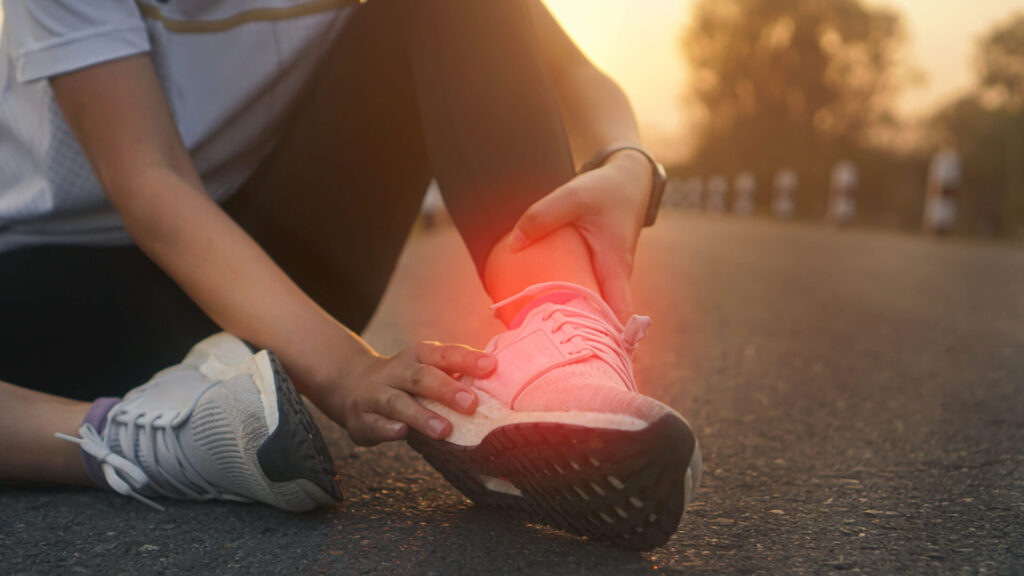Home » Blog » Sprains vs. Strains: What is the Difference?
Sprains vs. Strains: What is the Difference?
Sprains vs. Strains: Understanding Your Injured Joints
In sports and physical activity, injuries are an unfortunate reality. Among the most common are sprains and strains, which are often confused due to their similar symptoms and overlapping causes.
However, understanding the difference between these two types of injuries is crucial for proper diagnosis and effective treatment planning. If you want pain relief for your injury, you must first know what it is.
The team at Northeast Knee & Joint Institute can help you identify your issue and match you to a non-invasive treatment to help with your injury.
Defining Sprains and Strains
What is a Sprain?
A sprain involves stretching or tearing your ligaments. Your ligaments are the rough, fibrous tissues that connect bones to joints. Sprain injury treatments focus on repairing and strengthening these tissues.
Sprains are most common in the ankles, knees, and wrists, which are all high-use areas. Common injuries that cause even mild sprains include sudden twists, falls, or impacts that force a joint out of its normal range of motion.
What is a Strain?
A strain, on the other hand, occurs when muscles or tendons are stretched or torn rather than ligaments. Tendons are the fibrous cords that connect muscles to bones.
Strains commonly occur in the lower back and hamstrings. Overuse, sudden movements, or improper lifting of heavy objects cause strains more than anything else.
Similarities Between Sprains and Strains
Sprains and strains share several similarities that contribute to the confusion between the two, including:
- Both can result from physical activity and sudden movements, especially mild sprains.
- Symptoms often include pain, swelling, and restricted movement in the affected area.
- Both injuries benefit from early intervention and proper rehabilitation.
Differences Between Sprains and Strains
While both are considered soft-tissue injuries and share similarities, several key differences distinguish them, such as:
- Affected Tissues: Sprains affect ligaments, while strains involve muscles or tendons.
- Common Locations: Sprains are common in joints such as ankles, knees, and wrists, whereas strains are more likely to occur in the back or hamstrings.
- Mechanism of Injury: Sprains are usually caused by trauma or sudden twists, while strains often result from overuse or improper technique.
Symptoms of Sprains and Strains
Differentiating between a sprain and a strain can be challenging due to overlapping symptoms, particularly injured joints. However, some signs can help:
- Sprains: Pain localized around the soft tissue and joints, rapid swelling, bruising, and instability of the joint.
- Strains: Muscle spasms, cramping, weakness, and difficulty moving the soft tissue around the muscles or tendons.
Importance of Professional Diagnosis
Accurate diagnosis is essential for effective treatment. Physical therapists and healthcare professionals use various tools for assessment, including:
- Physical Examination: Assesses the range of motion, pain levels, and physical abnormalities in injured joints.
- Imaging Techniques: X-rays, MRI, and ultrasound to view the extent of the injury.
Sprain & Strain Injury Treatment Options
Initial treatment for both types of injuries often involves the RICE method:
- Rest: Avoiding activities that worsen the pain.
- Ice: Applying ice packs to reduce swelling.
- Compression: Using compression wraps to support the injured area.
- Elevation: Elevating the injured limb to reduce swelling.
Introduction to Regenerative Medicine
Advancements in medical technology have introduced regenerative medicine as an innovative approach to sprain recovery and strain recovery. At Northeast Knee & Joint Institute, we have experience in regenerative therapies that offer a safer and healthier way to heal sprains and strains.
- Stem Cell Therapy: Utilizing the body’s cells to repair damaged tissues speeds up recovery and enhances tissue regeneration.
- Platelet-Rich Plasma (PRP) Therapy: Injecting concentrated platelets to promote healing by releasing growth factors that aid tissue repair.
Contact Northeast Knee & Joint Institute for Information About Our Healing Treatments
Understanding how sprains and strains differ is the first step toward effective treatment and swift recovery. At Northeast Knee & Joint Institute, we are dedicated to helping people achieve optimal recovery through cutting-edge regenerative medicine.
If you or someone you know is dealing with a sprain or strain, don’t hesitate to seek professional advice tailored to your specific needs. Explore our regenerative medicine options and take the first step toward a healthier, more active life.
Learn more about how Northeast Knee & Joint Institute can help you heal through our regenerative treatments. Schedule a consultation today.

